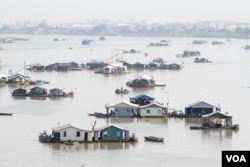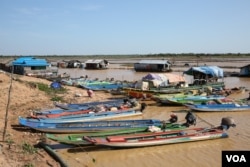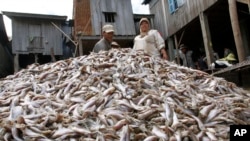CHARLOTTE, NORTH CAROLINA — The Tonle Sap Lake has been at heart of Cambodian civilization since ancient times, but this extraordinary ecosystem, and the millions of people who rely on it, are at critical juncture, threatened by a “trifecta” of local, regional and global destructive forces.
A new book by American journalist Abby Seiff describes the natural wonder of the lake’s connection to the Mekong River and the historical importance of its natural bounty to the Khmer people. But it warns that over the past decade a multi-level environmental crisis has pushed Asia’s most productive inland fishery to the brink of collapse.
During a recent discussion about the book, Seiff said that a local failure to stop overfishing, unbridled hydropower dam development in the Mekong Region, and global climate change were putting enormous stress on the lake. “All these things are working in concert… it’s a trifecta of problems,” she told Brian Eyler of the Stimson Center, a U.S. policy and research institute hosting the virtual talk.
Seiff described visiting various fishing communities—which live on shore, in wooden and bamboo stilt homes in the lake or in floating homes—and found most could no longer survive off the lake’s once-abundant freshwater fish catch. Many villagers were mired in debt and heading to urban areas in search of jobs, Seiff learned through reporting and research.
“Many fishers I spoke to want social support,” she said, explaining that they want alternative sources of livelihoods to supplement their fishing income.
Eyler said the book, titled “Troubling the Water: A Dying Lake and A Vanishing World in Cambodia,” stood out for its poignant personal stories of life on the lake, which were “a unique contribution to literature and ongoing discussions on the future of the Mekong.”
Droughts and government failures
A spate of dams constructed upstream in Laos and China in recent years, and irregular rainfall due to climate change, have caused extremely low water levels in the Mekong River. This, in turn, weakens the unique hydrological process that occurs in rainy season, when the swollen Mekong discharges into the lake through a tributary and increases its size seven-fold.
This feature supports a huge and highly diverse fish stock. This ranges from the critically endangered Giant Mekong Catfish to the tiny Trey Riel, which is caught in large volumes and turned into prahok, a fermented fish paste that is a staple and key source of protein in Cambodian food.
“Two years ago, the lake was just a quarter of its usual volume” in wet season, Seiff said, noting that such alarming situations had become a regular occurrence in recent years. “In 2016, there was horrific drought, forest fire and the fish catch was very low, so everybody was deeply in debt.”
Despite the lake’s status as UNESCO Biosphere Reserve, the Cambodian government has long failed to stem illegal fishing by both small fishermen and, more destructively, large-scale operators. Meanwhile, flooded forests that serve as fish habitat have been cleared by well-connected businessmen and local officials, who then rent it out for paddy farming.
Ministry of Agriculture spokesman Ung Try said he could not comment on the book’s claim of government failures as he had not read it, but added that “illegal fishing declined a lot” after recent measures. Last month, Prime Minister Hun Sen announced a crackdown on illegal fishing, encouraging local officials to ramp up law enforcement.
In the first week of April, 29 people were arrested and another 20 were summoned to court in six provinces, while 59 fishing boats were seized along with banned fishing equipment, including 1,200 meters of nets, according Ministry of Agriculture data provided to VOA Khmer.
Seiff, who worked for years with the local Phnom Penh Post and the now-shuttered Cambodia Daily, said Hun Sen’s order followed a familiar pattern of government public announcements and actions that lead to few results that meaningfully protect the lake.
“We don’t really hear about it afterwards and we don’t know the people are who are being arrested.” she said during the discussion. “I wouldn’t be surprised if these are the local and medium-level people, those are the easier ones to catch… But you need to look at the bigger people behind this systemic problem.”
Seiff, nonetheless, remains “hopeful in some ways as the government is recognizing the importance of the lake and the Mekong,” though it appears politically unwilling to tackle on-the-ground causes. Cambodia also has little influence on upstream dam development or international efforts at climate change reduction.
Widespread decline in catch, but a lack of data
The book, like much local media reporting, details how many fishers have witnessed the disappearance of many species, while their catch has become far less in recent years and is only a fraction of what the previous generation was able to haul in. Seiff also pointed to the rising prices for prahok fish in recent years as indication of a drop in catch of Trey Riel.
However, Seiff and Eyler noted that the absence of reliable scientific data on current fish stocks and volume of catch has made it difficult to ascertain the precise scale the problem.
“We really don’t know, that is the key issue. There is no good science and no good data on the state of Tonle Sap fisheries. And the data that comes out of the Cambodian government is often altered for political purposes, so there are reasons not to necessarily believe that wholesale,” said Eyler, who authored a 2019 book called “Last Days of the Mighty Mekong.”
A 2021 VOA Khmer investigation also raised questions about the accuracy of government data, which claimed a continued high annual catch that does not match with widespread local accounts of plummeting volumes.
The most recent government fisheries report dates from 2020 and states some 413,000 tons were caught. Which is significantly down from 524,000 tons the year before, though still above the roughly 400,000 tons in 2010 that the government reported to the UN’s Food and Agriculture Organization.
In Cambodian society, however, few people doubt that their storied ‘great’ lake and its fisheries are facing an existential threat.
“We have seen since a while ago that we import fish from Vietnam and Thailand to Cambodia. It's farmed fish. So where is the world-famous fish from the Tonle Sap basin?” said Yong Kim Eng, president of an NGO called People Center for Development and Peace.
“If we can't control [the Tonle Sap crisis] and if we don't take clear action, it will cause huge problems to the living standards of the people,” he said.







